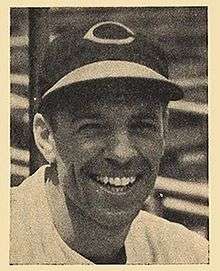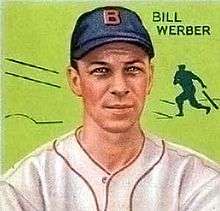Billy Werber
| Billy Werber | |||
|---|---|---|---|
 | |||
| Third baseman | |||
|
Born: June 20, 1908 Berwyn Heights, Maryland | |||
|
Died: January 22, 2009 (aged 100) Charlotte, North Carolina | |||
| |||
| MLB debut | |||
| June 25, 1930, for the New York Yankees | |||
| Last MLB appearance | |||
| September 5, 1942, for the New York Giants | |||
| MLB statistics | |||
| Batting average | .271 | ||
| Home runs | 78 | ||
| Runs batted in | 539 | ||
| Teams | |||
| Career highlights and awards | |||
| |||
William Murray Werber (June 20, 1908 – January 22, 2009) was a third baseman in Major League Baseball who played for the New York Yankees (1930, 1933), Boston Red Sox (1933–1936), Philadelphia Athletics (1937–1938), Cincinnati Reds (1939–1941) and New York Giants (1942). He led American League third basemen in putouts and assists once each, and also led National League third basemen in assists, double plays and fielding percentage once each. A strong baserunner, he led the AL in stolen bases three times and led the NL in runs in 1939 as the Reds won the pennant. He was born in Berwyn Heights, Maryland and batted and threw right-handed.
Biography

A 5'10", 170-pound infielder, Werber was at spring training and toured for several weeks in July with the Yankees in 1927. He returned to North Carolina to attend school at Duke University, where he was the first Duke basketball player to earn All-America honors. He was a member of the Sigma Chi fraternity, and a recipient of the Significant Sig Award. He played with Duke in spring and semi-pro ball in summers until 1930 when he officially becoming a Yankee rookie in 1930. He appeared in only four games that season, and was sent to the minors. In his first game he reached base five times including his first at bat where, according to Ford Frick (then a sportswriter, later commissioner of baseball): "Werber, in his first time at bat in big league competition, with two strikes on him watched the next four balls with the coolness of a veteran." Decades later, Werber enjoyed admitting that he was so frozen by fear that he was unable to move his arms to make a swing at the ball. In 1933, Frankie Crosetti was the obvious choice as the Yankees' shortstop, and with Tony Lazzeri at second base and Joe Sewell on third, Werber was expendable. Then, after playing only three games he was sold to the Boston Red Sox. The rest of the year he appeared in 108 games with Boston as a utility infielder at shortstop, second and third bases.
In 1934, Werber became the starting third baseman of the Red Sox. He responded with a career-high .321 batting average, including 200 hits; led the American League with 40 stolen bases, and posted double digits in doubles (41), triples (10) and home runs (11). He led the league in stolen bases in 1935 (29) and 1937 (35). Boston traded him to the Philadelphia Athletics for the 1937 season, and he joined the Cincinnati Reds in 1939.
In his first National League season, Werber became the first player ever to bat on television during a game between Cincinnati and the Brooklyn Dodgers at Ebbets Field (August 26, 1939). He ended with a .289 average in 147 games and led the league with 115 runs as Cincinnati faced the Yankees in the 1939 World Series, losing in four games. The next season belonged to Werber and the Reds, though, and although his batting numbers were generally down from 1939, he led the league with a .962 fielding average and finished 10th in voting for the NL's MVP Award. The 1940 World Series was the only Series in a six-year span that the Yankees did not win. Cincinnati beat the Detroit Tigers in seven games as Werber led his team with a .370 average (10-for-27). Werber still holds one Major League record, as he is the only player to hit four consecutive doubles in both leagues (with Boston in the A.L. and with the Reds in the N.L.) After that, he played with the New York Giants in 1942, his last major league season.
In an 11-season career, Werber was a .271 hitter with 78 home runs and 539 RBI in 1,295 games. One of the most aggressive baserunners of the 1930s, probably the most aggressive next to Ben Chapman, he stole 215 bases. He was inducted into the Cincinnati Reds Hall of Fame in 1961.
Werber's career was often framed in terms of his being a teammate of Babe Ruth and Lou Gehrig. While noteworthy, that wasn’t the measure of the man. He stood on his own and established a few records himself. Known as a tough competitor, Werber didn’t give an inch on the field and he prided himself on working hard and occasionally outsmarting his opponents. He took second base on a walk once while noting that the catcher turned to argue the ball four call as he left the batter's box. On the long train rides that were common then, he was often called on to be the arbiter in disputes and confer his knowledge upon the less educated ballplayers of the day. In all things he was gracious and dignified.
Werber had a very successful business career following his retirement from baseball. He began selling pension plans, and his work ethic and good communication skills yielded outstanding results. He ultimately oversaw the operations of the Werber Insurance Agency, started by his father in 1904. He was a top producer until his retirement in the early 1970s. He retired to Naples, Florida, but lived in a retirement home in Charlotte, North Carolina until the time of his death. Late in his life Werber authored three books: Circling the Bases (1978), Hunting Is for the Birds (1981), and Memories of a Ballplayer (2001).
The Bill Werber most would never know from reading articles about him was a man who possessed the most fantastic vocabulary, and he enjoyed the full use of it. Although he never made the Baseball Hall of Fame, he surely would be a charter member of the Storytellers Hall of Fame, if one existed. He told vivid tales of moments large and small with a total recall of the little details that made it all so real for the fortunate recipient. Not just stories of the Babe, but also stories about hunting trips with President Eisenhower and caring for his beloved bird dogs, and stories about most everything in between. He was a big talker and he was very good at it. He was also a man of strong opinions and even after his 100th birthday, he would share them with our political leaders and others he thought would benefit from his perspective.
Prior to his death Werber said that he no longer watched baseball; one of his stated reasons was that he was dismayed to see Johnny Damon's long hair and beard.[1] In 2008, Werber said, "I don't like the appearance of a lot of the players. The hair's too long. Their beards are too evident. They're a grubby-looking bunch of caterwaulers."[2]
Death
Werber died on January 22, 2009, in Charlotte, North Carolina, at age 100.
At the time of his death, Werber was recognized as the oldest living former player of Major League Baseball. Werber was also the final surviving teammate of Babe Ruth. The last living opponent of Ruth was Phil Cavarretta, who died in 2010.
See also
- List of Major League Baseball annual runs scored leaders
- List of Major League Baseball annual stolen base leaders
- List of Major League Baseball career stolen bases leaders
- List of centenarians (Major League Baseball players)
- List of centenarians (sportspeople)
Bibliography
- Circling the Bases by Bill Werber (self-published, 1978)
- Hunting Is for the Birds by Bill Werber (self-published, 1981)
- Memories of a Ballplayer: Bill Werber and Baseball in the 1930s by Bill Werber and C. Paul Rogers III (SABR, 2001) ISBN 0-910137-84-6
References
- ↑ Gordon Edes (2008-01-20). "Storied Career". The Boston Globe.
- ↑ John Rutherford (2008-07-15). "Babe's Old Teammate No Fan of 'Grubby" Ball Players". MSNBC.
External links
- Career statistics and player information from Baseball-Reference
- profile and career highlights Baseball Library
- Baseball Almanac
- Retrosheet
- The Baseball Cube
- The Melrose Mirror
- MLB – The Fall Classic's elder statesman
- 2008 Boston Globe interview
- Ex-Big Leaguer Werber Has Many Stories to Choose From – June 2008 Washington Post interview
- USAToday article on June 20, 2008
- NYTimes obituary
| Records | ||
|---|---|---|
| Preceded by Rollie Stiles |
Oldest recognized verified living baseball player July 22, 2007 – January 22, 2009 |
Succeeded by Tony Malinosky |